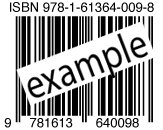Step Three
Obtaining a ISBN Code and Copyright
Your Book's ISBN Code

In 1970, the International Organization for Standardization (ISO) published international standard ISO 2108, which established the 10-digit ISBN (International Standard Book Number). As of 2007, it is now a 13-digit number. You should get one for each edition and variation (except reprintings) of a publication. So, you should get one to uniquely identify the hard cover, paperback, and electronic versions of your book.
NOTE: If your book will never be found in stores, libraries, or with wholesalers, it does not need an ISBN. eBooks also do not need an ISBN.
To get ISBNs for your book, simply search for “affiliate of the International ISBN Agency” and purchase then download them. I used ISBN Agency.com at https://www.isbnagency.com/. Each ISBN costs a fee. After I paid the fees for each version of each book, this site provided my downloadable .JPG files for free.
Place the ISBN JPG on the back lower left or right corner of your book’s cover. A quick survey of my small library reveals most are found in the lower right corner near the spine but not on any part of the spine.

Your Book's Copyright
A copyright is “the exclusive legal right, given to an originator or an assignee to print, publish, perform, film, or record literary, artistic, or musical material, and to authorize others to do the same.”
You own the copyright of your book as soon as you create it. Proving that you own it is another matter. You could trust that it is commonly recognized that you own the copyright to your book, but you are advised to register your book with the government and be on record as having the copyright to your book. You can do this at https://www.copyright.gov/registration/literary-works/ Yes, there is a fee.
Whether you register your copyright or do not register it, include a © Copyright statement on a copyright page in the front matter of our book such as:
© Copyright Your Name 2020. All rights reserved.